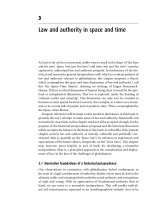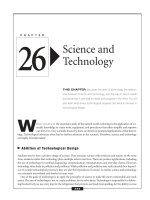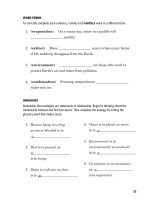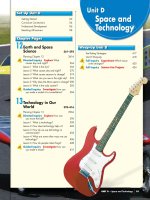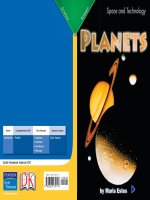planets space and technology
Bạn đang xem bản rút gọn của tài liệu. Xem và tải ngay bản đầy đủ của tài liệu tại đây (5.72 MB, 14 trang )
Scott Foresman Science 4.18
Genre Comprehension Skill Text Features Science Content
Nonfi ction Predict • Captions
• Call Outs
• Text Boxes
• Glossary
Solar System
ISBN 0-328-13911-4
ì<(sk$m)=bdjbbi< +^-Ä-U-Ä-U
13911_01-04_CVR_FSD.indd Cover113911_01-04_CVR_FSD.indd Cover1 5/12/05 8:42:13 PM5/12/05 8:42:13 PM
Scott Foresman Science 4.18
Genre Comprehension Skill Text Features Science Content
Nonfi ction Predict • Captions
• Call Outs
• Text Boxes
• Glossary
Solar System
ISBN 0-328-13911-4
ì<(sk$m)=bdjbbi< +^-Ä-U-Ä-U
13911_01-04_CVR_FSD.indd Cover113911_01-04_CVR_FSD.indd Cover1 5/12/05 8:42:13 PM5/12/05 8:42:13 PM
1. How are the orbits of the inner
planets different from the orbits
of the outer planets?
2. Why is it diffi cult to study Venus?
3. What makes Pluto’s orbit different from
all the other planets?
4.
Gravity is the force
that holds the solar system together.
Write to explain what effect gravity has
between the Sun and the planets, and
between the planets and their moons.
Use details from the book to support
your answer.
5.
Predict Do you think scientists will
fi nd other planets in the solar system?
Explain your prediction.
What did you learn?
Vocabulary
astronomy
craters
galaxy
satellite
solar system
space probe
universe
Picture Credits
Every effort has been made to secure permission and provide appropriate credit for photographic material.
The publisher deeply regrets any omission and pledges to correct errors called to its attention in subsequent editions.
Photo locators denoted as follows: Top (T), Center (C), Bottom (B), Left (L), Right (R), Background (Bkgd).
Opener Brand X Pictures; 2 (T) ©Myron Jay Dorf/Corbis; 3 Getty Images; 7 (T) Brand X Pictures; 10 (TL, BR) Brand X
Pictures; 11 (BR) Getty Images; 13 (TR) Getty Images, (BR) ©JPL/NASA; 14 (TR) Getty Images; 16 (TR) Getty Images;
17 (TR) Getty Images, (CR, BR) Calvin J Hamilton/©Galaxy Picture Library; 23 (CR) NASA/JPL-Caltech/©Galaxy Picture
Library.
Scott Foresman/Dorling Kindersley would also like to thank: 1, 2 (B) NASA/JPL/DK Images; 6 (TL) NASA/DK Images, (TR)
NASA/Finley Holiday Films/DK Images; 9 (TR) NASA/DK Images; 11 (T) NASA/DK Images; 12 NASA/DK Images; 15 (CL, BL)
Jet Propulsion Lab/DK Images; 19 (TR, CL) Jet Propulsion Lab/DK Images; 21 (BR) NASA/JPL/DK Images.
Unless otherwise acknowledged, all photographs are the copyright © of Dorling Kindersley, a division of Pearson.
ISBN: 0-328-13911-4
Copyright © Pearson Education, Inc. All Rights Reserved. Printed in the United States of America.
This publication is protected by Copyright, and permission should be obtained from the publisher prior to any
prohibited reproduction, storage in a retrieval system, or transmission in any form by any means, electronic,
mechanical, photocopying, recording, or likewise. For information regarding permission(s), write to
Permissions Department, Scott Foresman, 1900 East Lake Avenue, Glenview, Illinois 60025.
3 4 5 6 7 8 9 10 V010 13 12 11 10 09 08 07 06 05
13911_01-04_CVR_FSD.indd Cover213911_01-04_CVR_FSD.indd Cover2 5/12/05 8:42:20 PM5/12/05 8:42:20 PM
by Maria Estes
13911_05-28_FSD.indd 113911_05-28_FSD.indd 1 5/12/05 8:43:38 PM5/12/05 8:43:38 PM
The universe is all of space and everything in
it. The universe has millions of galaxies. A galaxy
is a system of billions of stars, gases, and dust.
The galaxy that we live in is called the Milky Way.
When you look at the night sky, most of the stars
you see are part of the Milky Way. From Earth,
it looks like a glowing band of light that stretches
across the sky.
If you could look down on the Milky Way, it
would look similar to a spinning pinwheel. It is
thicker at the center than at the edges.
The Universe
2
13911_05-28_FSD.indd 213911_05-28_FSD.indd 2 5/12/05 8:43:45 PM5/12/05 8:43:45 PM
3
This is how the Milky Way would
look if you could look down on it.
Our solar system is just one tiny
part of this galaxy.
The study of the Sun, Moon, stars, and other objects
in space is called astronomy. Early astronomers noticed
that most of the lights in the sky remained in the same
place. A few of them, however, moved across the sky.
We call these moving objects “planets.” The word planet
comes from the Greek word planetes, meaning “wanderer.”
Other early civilizations also studied the Sun and
the stars. Stonehenge is a giant circle of stones in England.
Scientists believe that the ancient people who built this
had a good understanding of the movements and patterns
of the Sun and the stars. Some of the stones point to
where the Sun rises and sets on the longest day of the year.
Stonehenge
13911_05-28_FSD.indd 313911_05-28_FSD.indd 3 5/12/05 8:43:56 PM5/12/05 8:43:56 PM
4
The solar system includes the Sun, the planets and
their moons, and other objects. The Sun is in the center
of the solar system. All the other objects in the solar
system travel around the Sun in a path called an orbit.
A planet is a very large, round object that moves
around a star. Earth is a planet that moves around
the Sun. The Sun is a star. Planets are cooler than stars.
They are also smaller than stars. Planets don’t give off
their own light, as stars do. They refl ect light from
the star that they orbit.
The Solar System
Neptune
Jupiter
Earth
Mercury
asteroid belt
13911_05-28_FSD.indd 413911_05-28_FSD.indd 4 5/12/05 8:44:05 PM5/12/05 8:44:05 PM
5
Our solar system has inner and outer planets.
Mercury, Venus, Earth, and Mars are the inner planets.
They are solid and rocky. Jupiter, Saturn, Uranus,
Neptune, and Pluto are the outer planets. With the
exception of Pluto, these planets are made mostly
of gas or ice.
Asteroids are rocky objects that are too small to
be called planets. Asteroids travel around the Sun
in a path between Mars and Jupiter. This area is
called the asteroid belt.
Pluto
Uranus
The Sun
Saturn
Mars
Venus
13911_05-28_FSD.indd 513911_05-28_FSD.indd 5 5/12/05 8:44:08 PM5/12/05 8:44:08 PM
6
Gravity is the force that holds the solar system
together. Without gravity, the planets would move
in a straight line off into space. The Sun’s gravity
pulls the planets toward it. This pull from the Sun
makes the planets move in orbits around it.
Look at the diagram of the solar system above.
The orbits of the inner planets are almost in the shape
of circles. The orbits of the outer planets are not quite
as round. Their orbits are longer and narrower than
those of the inner planets.
This is our solar system as viewed from above. Pluto has
a much narrower orbit than the other planets have.
What is gravity?
Neptune
Uranus
Jupiter
Earth
Mercury
Saturn
Mars
Venus
Pluto
Sun
The sizes
and distances
in this diagram
are not true to scale.
13911_05-28_FSD.indd 613911_05-28_FSD.indd 6 5/12/05 8:44:10 PM5/12/05 8:44:10 PM
7
The Sun
Our Sun is an average-sized star. But it is big enough
that all the planets and their moons could fi t in a small
corner of it! The Sun, like all other stars, is a huge ball
of very hot gases. Energy from the Sun provides light
and heat on Earth.
The inner parts of the Sun are much hotter than the
outer parts. Scientists have not been able to actually
record the temperature of the Sun. However, they
believe that the outer part of the Sun is about 5,500°C
(10,000°F). The inside of the Sun could be as hot as
15,000,000°C (27,000,000°F).
The Sun’s
gravity holds
its gases together
in the shape of a ball.
13911_05-28_FSD.indd 713911_05-28_FSD.indd 7 5/12/05 8:44:32 PM5/12/05 8:44:32 PM
8
The Inner
Planets
Mercury is the planet closest to the
Sun. It’s only a little bigger than Earth’s moon. The
surface of Mercury is covered with huge, bowl-shaped
dents called craters.
In late 1973, scientists sent the Mariner 10 space
probe to Mercury to gather information. A space probe
is a vehicle that carries cameras and other tools for
studying objects in space.
It is very hot on Mercury during the day. The
hottest temperature recorded on Mercury was 467°C
(870°F). But it has almost no atmosphere to hold the
Sun’s heat. This makes the nights very cold. The coldest
temperature recorded on Mercury was –183°C (–297°F).
Facts about Mercury
Distance from the Sun: 57,900,000 km (35,983,000 mi)
Diameter: 4,879 km (3,032 mi)
Length of a day as measured in Earth time: 59 days
Length of a year as measured in Earth time: 88 days
Average surface temperature: 117°C (243°F)
Number of moons: none
Weight of a child who is 75 lb on Earth: 28.5 lb
Mercury
The surface of
Mercury has long
cracks and ridges.
13911_05-28_FSD.indd 813911_05-28_FSD.indd 8 5/12/05 8:44:41 PM5/12/05 8:44:41 PM
9
Venus
Venus is about the
same size as Earth. Venus
is diffi cult to study because
it is always covered
by thick,
hot, poisonous clouds. The
clouds
on Venus refl ect the Sun’s
light. This makes Venus one of the
brightest objects in Earth’s night sky.
Similar to Mercury, Venus is hot and dry. It also is
covered by craters, cracks, and ridges. Venus is the
hottest planet in the solar system. Ten Russian space
probes have been able to land on the surface of Venus.
Several of them sent photographs back to Earth before
they were destroyed by the heat.
The thick clouds that cover
Venus are hot and poisonous.
Distance from the Sun: 108,200,000 km (67,200,000 mi)
Diameter: 12,104 km (7,521 mi)
Length of a day as measured in Earth time: 243 days; spins backward
Length of a year as measured in Earth time: 225 days
Average surface temperature: 464°C (867°F)
Number of moons: none
Weight of a child who is 75 lb on Earth: 68.25 lb
Facts about Venus
13911_05-28_FSD.indd 913911_05-28_FSD.indd 9 5/12/05 8:44:50 PM5/12/05 8:44:50 PM
10
Earth is the largest rocky planet in our solar system.
It is colder at night and warmer during the day. No other
planet in the solar system has any liquid water on its
surface. Much of Earth’s surface is covered with water.
The atmosphere is a layer of gas. Earth has a different
atmosphere than other planets have. The atmosphere is
about 150 kilometers (93 miles) thick. The gases in the
atmosphere block some of the Sun’s harmful rays. Some
of these gases are nitrogen, oxygen, and carbon dioxide.
Plants and animals need water and these gases to live.
Earth is the only planet in the solar system that is known
to support life.
Earth rotates around its
axis every twenty-four
hours. Half of Earth
is always in darkness.
Distance from the Sun: 149,600,000 km (93,000,000 mi)
Diameter: 12,756 km (7,926 mi)
Length of a day as measured in Earth time: 24 hours
Length of a year as measured in Earth time: 365 days
Average surface temperature: 15°C (59°F)
Number of moons: 1
Weight of a child who is 75 lb on Earth: 75 lb
Earth
Facts about Earth
13911_05-28_FSD.indd 1013911_05-28_FSD.indd 10 5/12/05 8:44:58 PM5/12/05 8:44:58 PM
11
The Moon
An astronaut walks on the Moon.
A moon is a natural satellite of a planet. A
satellite is an object that travels around another object
in space. Moons orbit planets, just as planets orbit
the Sun. Gravity keeps moons traveling in orbits
around planets.
Earth’s moon is about one-fourth the size of
Earth. The Moon has no air, water, or atmosphere.
The country that was known as the Soviet Union
sent the fi rst man-made satellite, called Sputnik 1,
into space in 1957. In 1961, a Soviet cosmonaut
named Yuri Gagarin became the fi rst person in space.
In 1969, Americans Neil Armstrong and Buzz Aldrin
were the fi rst people to walk on the Moon.
Distance from Earth: 385,000 km (239,000 mi)
Diameter: 3,475 km (2,159 mi)
Time it takes to travel around Earth: 27.3 days
Range of temperatures: –233°C to 123°C (–387°F to 253°F)
Weight of a child who is 75 lb on Earth: 12 lb
Facts about Earth’s Moon
13911_05-28_FSD.indd 1113911_05-28_FSD.indd 11 5/12/05 8:45:19 PM5/12/05 8:45:19 PM
12
Astronomers have nicknamed Mars the “Red Planet.”
The rocks and dirt that cover the surface of Mars contain
a mineral called iron oxide. Iron oxide is rust. Mars and
the dust that swirls around it are a rusty, red color.
Mars has two moons called Phobos and Deimos.
Phobos is very close to Mars. It is only about 6,000 km
(3,700 mi) away from Mars. That is much closer than
the Moon is to Earth. Earth’s moon is 385,000 km
(239,000 mi) from Earth.
The atmosphere on Mars has very little oxygen. No
plants or animals that need oxygen to live could survive
on Mars. Strong winds can cause huge dust storms.
The red dust that covers the planet is blown around.
Reddish-pink clouds often surround the entire planet.
Distance from the Sun: 227,900,000 km (141,600,000 mi)
Diameter: 6,794 km (4,222 mi)
Length of a day as measured in Earth time: 25 hours
Length of a year as measured in Earth time: 687 days
Average surface temperature: –63°C (–81°F)
Number of moons: 2
Weight of a child who is 75 lb on Earth: 28.5 lb
Mars
Facts about Mars
13911_05-28_FSD.indd 1213911_05-28_FSD.indd 12 5/12/05 8:45:37 PM5/12/05 8:45:37 PM
13
Opportunity
Ice caps cover small
areas on Mars. There are
also many volcanoes and
canyons on Mars. The
Valles Marineris canyon
is more than 4,000 km
(1,864 mi) long. That’s about
the same as the distance from
New York City to Los Angeles.
The fi rst space probe to land on Mars was
called Viking I. In 2004, two vehicles called Spirit
and Opportunity landed on Mars. These robotlike
machines gathered samples, such as dirt and rocks,
and sent information about them back to Earth.
13911_05-28_FSD.indd 1313911_05-28_FSD.indd 13 5/12/05 8:45:42 PM5/12/05 8:45:42 PM
Jupiter, Saturn,
And Uranus
Jupiter is the largest planet
in the solar system. It is a gas giant.
This means that it is made mostly
of gas, not rock. Space probes have
fl own by Jupiter to get information.
However, they are not able to land on
Jupiter. It does not have any solid surface.
The gases in Jupiter’s atmosphere are mostly
hydrogen and helium. Jupiter’s atmosphere has
a weather system called the Great Red Spot.
This huge storm has been going on for more than
three hundred years! Jupiter has rings around it,
but they are too thin and dark to be seen from Earth.
Great Red Spot
Distance from the Sun: 778,400,000 km (484,000,000 mi)
Diameter: 142,984 km (88,846 mi)
Length of a day as measured in Earth time: 10 hours
Length of a year as measured in Earth time: 12 years
Average surface temperature: –148°C (–234°F)
Number of moons: at least 63
Rings: yes
Weight of a child who is 75 lb on Earth: 160.5 lb
Jupiter
Facts about Jupiter
14
13911_05-28_FSD.indd 1413911_05-28_FSD.indd 14 5/12/05 8:45:50 PM5/12/05 8:45:50 PM
Jupiter’s largest moons are Io,
Europa, Ganymede, and Callisto.
They are about the same size as
Earth’s moon.
Io has many active volcanoes.
They give off a gas that appears as
different shades of yellow, orange,
and green.
The surface of Europa is a frozen
crust that is several miles thick.
Scientists believe that an ocean of
saltwater might lie under this crust.
Ganymede is the largest moon
in the solar system. It is even bigger
than Mercury and Pluto.
Callisto is covered with craters.
Scientists think that there might be a
frozen ocean far below its rocky crust.
Colorful yellow, orange, red, and
white clouds swirl around Jupiter.
Io
Europa
Ganymede
Callisto
15
13911_05-28_FSD.indd 1513911_05-28_FSD.indd 15 5/12/05 8:45:56 PM5/12/05 8:45:56 PM
16
Saturn is a gas giant made of
mostly hydrogen and helium. Saturn
is a very large planet—only Jupiter is
larger. It is a gigantic ball of gases that
contains very little solid matter.
Saturn is surrounded by rings. In 1981,
the Voy ager space probe collected information
about the particles that make up the rings. These
particles can be as small as grains of sand or as
large as boulders. They are probably made of ice,
dust, and chunks of rock.
Saturn
Galileo thought Saturn had handles when he
fi rst saw it through his telescope. The handles were
the colorful rings that surround Saturn.
Galileo’s Handles
Facts about Saturn
Distance from the Sun: 1,426,700,000 km (885,900,000 mi)
Diameter: 120,536 km (74,897 mi)
Length of a day as measured in Earth time: 11 hours
Length of a year as measured in Earth time: 29 years
Average surface temperature: –178°C (–288°F)
Number of moons: at least 33
Rings: yes
Weight of a child who is 75 lb on Earth: 55.5 lb
13911_05-28_FSD.indd 1613911_05-28_FSD.indd 16 5/12/05 8:46:01 PM5/12/05 8:46:01 PM
17
Moons of Saturn
Rhea
Astronomers have discovered that Saturn has
at least thirty-three moons. Some are small chunks
of ice with odd shapes, such as Pan and Atlas.
Others are medium-sized round balls, such as Dione
and Rhea. Titan, Saturn’s largest moon, is even larger
than Mercury and Pluto. Titan is the only moon in
the solar system that has an atmosphere.
Saturn’s rings are made
of billions of particles
that travel in orbits
around the planet.
Titan
Atlas
13911_05-28_FSD.indd 1713911_05-28_FSD.indd 17 5/12/05 8:46:12 PM5/12/05 8:46:12 PM
18
Uranus was the fi rst planet
discovered using a telescope.
This planet is a gas giant. Its
atmosphere is made of mostly
hydrogen, helium, and methane.
Uranus is so cold that the methane
in the atmosphere is a liquid.
Tiny drops of methane form
clouds that surround the planet.
These clouds make Uranus
a fuzzy blue-green color.
The rings of Uranus are dark
and diffi cult to see from Earth
even with powerful telescopes. In
fact, astronomers didn’t know that
Uranus had rings until they were
discovered by a space probe
in 1977.
Uranus travels around the Sun
on its side. Scientists think that
an object as large as Earth might
have crashed into the planet when
the solar system was still forming.
This might have knocked Uranus
onto its side.
Uranus is nearly
2 billion miles away
from the Sun. The
cameras on Voyager 2
had to be adjusted to
take photographs in
such dim light.
Uranus
13911_05-28_FSD.indd 1813911_05-28_FSD.indd 18 5/12/05 8:46:22 PM5/12/05 8:46:22 PM
19
The Moons of Uranus
Scientists know that Uranus
has at least twenty-seven moons.
More may be discovered in
the future. Vo y ager 2 is the
only space probe to fl y near
Uranus. When it fl ew past the
planet in 1986, it discovered ten
small moons that astronomers had
not known about. The moons are all small
to medium-sized. The larger moons have deep
valleys and craters.
Facts about Uranus
Distance from the Sun: 2,871,000,000 km (1,784,000,000 mi)
Diameter: 51,118 km (31,763 mi)
Length of a day as measured in Earth time: 17 hours; spins backward
Length of a year as measured in Earth time: 84 years
Average surface temperature: –216°C (–357°F)
Number of moons: at least 27
Rings: yes
Weight of a child who is 75 lb on Earth: 64.5 lb
Miranda
Arial
Oberon
13911_05-28_FSD.indd 1913911_05-28_FSD.indd 19 5/12/05 8:46:32 PM5/12/05 8:46:32 PM
20
Neptune, Pluto,
And Beyond
Neptune is the smallest of the gas
giants, but it’s still enormous. If it were hollow,
sixty objects the size of Earth could fi t inside!
Neptune can’t be seen without a telescope.
The force of gravity between the Sun and the
outer planets is weaker than the force of gravity
among the Sun and the inner planets. Since
Neptune is so far away from the Sun, its orbit is
very long. It takes more than one hundred Earth
years for Neptune to circle the Sun one time.
Neptune is very windy. Neptune’s winds blew
a huge storm called the Great Dark Spot across
the planet.
Distance from the Sun: 4,498,300,000 km (2,795,000,000 mi)
Diameter: 49,528 km (30,775 mi)
Length of a day as measured in Earth time: 16 hours
Length of a year as measured in Earth time: 165 years
Average surface temperature: –214°C (–353°F)
Number of moons: at least 13
Rings: yes
Weight of a child who is 75 lb on Earth: 82.5 lb
Neptune
Facts about Neptune
13911_05-28_FSD.indd 2013911_05-28_FSD.indd 20 5/12/05 8:46:45 PM5/12/05 8:46:45 PM
21
The Moons of Neptune
Triton
In the 1800s, British astronomer John Couch Adams
noticed that Uranus’s orbit was not following the
path he thought it should. He thought that the force
of gravity between Uranus and another, undiscovered
planet might be the cause.
At the same time, a man named Urbain Leverrier
calculated the location and size of the other planet. In
1846, an astronomer named Johann Galle pointed his
telescope where Leverrier predicted the planet would be.
There was Neptune!
Neptune has at least thirteen moons.
The largest is called Triton. Astronomers think
that Triton may have formed farther away from
the Sun and was grabbed by Neptune’s gravity.
On Neptune, the methane gas
in the atmosphere makes the
planet look very blue.
Great Dark Spot
13911_05-28_FSD.indd 2113911_05-28_FSD.indd 21 5/12/05 8:46:50 PM5/12/05 8:46:50 PM
22
Pluto is the planet farthest from the Sun. It is the
only outer planet that is not a gas giant. Its surface is
icy and solid. Pluto is the smallest planet in the solar
system. It’s even smaller than our own moon.
Pluto has one moon. It is called Charon. Charon
is very close to Pluto and is only slightly smaller. This
makes many astronomers think of them as a double
planet system. Astronomers also believe that Pluto and
Charon may share the same atmosphere when their
orbits bring them closest to the Sun.
Distance from the Sun: 5,906,300,000 km (3,670,000,000 mi)
Diameter: 2,302 km (1,430 mi)
Length of a day as measured in Earth time: 6 days; spins backward
Length of a year as measured in Earth time: 248 years
Average surface temperature: –233°C (–387°F)
Number of moons: 1
Weight of a child who is 75 lb on Earth: 6 lb
Facts about Pluto
Pluto
Pluto
Charon
13911_05-28_FSD.indd 2213911_05-28_FSD.indd 22 5/12/05 8:47:01 PM5/12/05 8:47:01 PM
23
Sedna
Look at the diagram above. The other planets all travel
around the Sun at the same angle. Pluto’s orbit is tilted.
It takes 248 years for Pluto to travel around the Sun. For
twenty of those years, Pluto is closer to the Sun than
Neptune. This won’t happen again until the year 2237.
Is Sedna the tenth planet?
Sedna was fi rst seen in 2003. It is
the largest object discovered in the
solar system since Pluto was spotted
in 1930. Sedna is about 84 billion
miles away from the Sun. Because of
that great distance, it has a temperature of
–240°C. Sedna is red, just as Mars is. Sedna is not
the only object that astronomers have seen beyond Pluto.
However, all the others seem to be too small to be planets.
Spacecraft have landed on or passed by every planet up
to Pluto. Space probes might land on Pluto one day. Will
that be the end of our exploration? Probably not. With
perhaps 50 billion solar systems in the Milky Way alone, it
seems that space exploration has only just begun!
Pluto’s orbit
Sedna
13911_05-28_FSD.indd 2313911_05-28_FSD.indd 23 5/12/05 8:47:13 PM5/12/05 8:47:13 PM
24
Glossary
astronomy the study of the Sun, Moon, stars,
and other objects in space
craters bowl-shaped dents on the surface of
planets and their moons
galaxy a system of billions of stars, gases,
and dust
satellite an object that travels around another
object in space
solar system a system that includes the Sun,
the planets, their moons, and
other objects
space probe a vehicle that carries cameras and
other tools for studying objects
in space
universe all of space and everything in it
13911_05-28_FSD.indd 2413911_05-28_FSD.indd 24 5/12/05 8:47:24 PM5/12/05 8:47:24 PM
1. How are the orbits of the inner
planets different from the orbits
of the outer planets?
2. Why is it diffi cult to study Venus?
3. What makes Pluto’s orbit different from
all the other planets?
4.
Gravity is the force
that holds the solar system together.
Write to explain what effect gravity has
between the Sun and the planets, and
between the planets and their moons.
Use details from the book to support
your answer.
5.
Predict Do you think scientists will
fi nd other planets in the solar system?
Explain your prediction.
What did you learn?
Vocabulary
astronomy
craters
galaxy
satellite
solar system
space probe
universe
Picture Credits
Every effort has been made to secure permission and provide appropriate credit for photographic material.
The publisher deeply regrets any omission and pledges to correct errors called to its attention in subsequent editions.
Photo locators denoted as follows: Top (T), Center (C), Bottom (B), Left (L), Right (R), Background (Bkgd).
Opener Brand X Pictures; 2 (T) ©Myron Jay Dorf/Corbis; 3 Getty Images; 7 (T) Brand X Pictures; 10 (TL, BR) Brand X
Pictures; 11 (BR) Getty Images; 13 (TR) Getty Images, (BR) ©JPL/NASA; 14 (TR) Getty Images; 16 (TR) Getty Images;
17 (TR) Getty Images, (CR, BR) Calvin J Hamilton/©Galaxy Picture Library; 23 (CR) NASA/JPL-Caltech/©Galaxy Picture
Library.
Scott Foresman/Dorling Kindersley would also like to thank: 1, 2 (B) NASA/JPL/DK Images; 6 (TL) NASA/DK Images, (TR)
NASA/Finley Holiday Films/DK Images; 9 (TR) NASA/DK Images; 11 (T) NASA/DK Images; 12 NASA/DK Images; 15 (CL, BL)
Jet Propulsion Lab/DK Images; 19 (TR, CL) Jet Propulsion Lab/DK Images; 21 (BR) NASA/JPL/DK Images.
Unless otherwise acknowledged, all photographs are the copyright © of Dorling Kindersley, a division of Pearson.
ISBN: 0-328-13911-4
Copyright © Pearson Education, Inc. All Rights Reserved. Printed in the United States of America.
This publication is protected by Copyright, and permission should be obtained from the publisher prior to any
prohibited reproduction, storage in a retrieval system, or transmission in any form by any means, electronic,
mechanical, photocopying, recording, or likewise. For information regarding permission(s), write to
Permissions Department, Scott Foresman, 1900 East Lake Avenue, Glenview, Illinois 60025.
3 4 5 6 7 8 9 10 V010 13 12 11 10 09 08 07 06 05
13911_01-04_CVR_FSD.indd Cover213911_01-04_CVR_FSD.indd Cover2 5/12/05 8:42:20 PM5/12/05 8:42:20 PM
